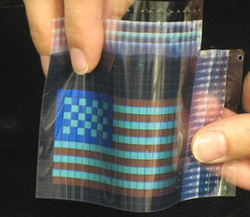
Rotatable diffraction gratings based on cholesteric liquid crystals with phototunable helix pitch. Surface induced phase separation and pattern formation at the isotropic interface in chiral nematic liquid crystals. The use of mould-templated surface structures for high-quality uniform-lying-helix liquid-crystal alignment. Periodic anchoring condition for alignment of a short pitch cholesteric liquid crystal in uniform lying helix texture. Short pitch cholesteric electro-optical device based on periodic polymer structures. Flexoelectro-optic effect in a hybrid nematic liquid crystal cell. Photoinduced helical inversion in cholesteric liquid crystal cells with homeotropic anchoring. Gvozdovskyy, I., Yaroshchuk, O., Serbina, M. Cholesteric gratings with field-controlled period. Light-directing chiral liquid crystal nanostructures: from 1D to 3D. Photochemically induced reversible color changes in cholesteric liquid crystals. Photoresponsive monodisperse cholesteric liquid crystalline microshells for tunable omnidirectional lasing enabled by a visible light-driven chiral molecular switch. Fabrication of a simultaneous red-green-blue reflector using single-pitched cholesteric liquid crystals. Electrically tunable selective reflection of light from ultraviolet to visible and infrared by heliconical cholesterics. Reflective Liquid Crystal Displays (John Wiley, 2001) Cutaneous thermography with liquid crystals. We also describe reversible photocontrol between a two-dimensional diffraction state, a one-dimensional diffraction state and a diffraction ‘off’ state in a bilayer cell.Ĭrissey, J. Because there is no thermal relaxation, the system can be driven either forwards or backwards from any light-activated intermediate state. Such reversible manipulation depends on experimental parameters such as cell thickness, surface anchoring condition, and pitch length.

During the three-dimensional manipulation by light, the helical axis undergoes, in sequence, a reversible transition from perpendicular to parallel, followed by in-plane rotation on the substrate surface. We use this technique to carry out light-activated, wide-area, reversible two-dimensional beam steering-previously accomplished using complex integrated systems 20 and optical phased arrays 21. Here we report three-dimensional manipulation of the helical axis of a CLC, together with inversion of its handedness, achieved solely with a light stimulus. For example, the orientation of the helical axis relative to the substrate can be changed from perpendicular to parallel by applying an alternating-current electric field 9, by changing the anchoring conditions of the substrate, or by altering the topography of the substrate’s surface 10, 11, 12, 13, 14, 15, 16 separately, in-plane rotation of the helical axis parallel to the substrate can be driven by a direct-current field 17, 18, 19. Dynamic, remote and three-dimensional control over the helical axis of CLCs is desirable, but challenging 7, 8. Chiral nematic liquid crystals-otherwise referred to as cholesteric liquid crystals (CLCs)-are self-organized helical superstructures that find practical application in, for example, thermography 1, reflective displays 2, tuneable colour filters 3, 4 and mirrorless lasing 5, 6.


 0 kommentar(er)
0 kommentar(er)
